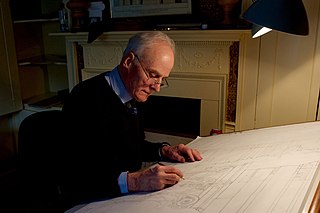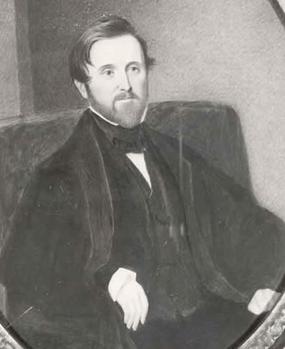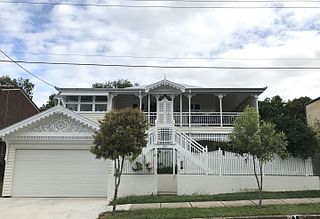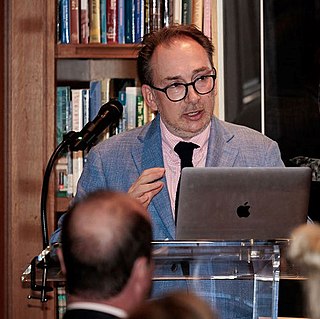
Greek Revival architecture was a style that began in the middle of the 18th century but which particularly flourished in the late 18th and early 19th centuries, predominantly in northern Europe, the United States, and Canada, as well as in Greece itself following its independence in 1832. It revived many aspects of the forms and styles of ancient Greek architecture, in particular the Greek temple. A product of Hellenism, Greek Revival architecture is looked upon as the last phase in the development of Neoclassical architecture, which was drawn from Roman architecture. The term was first used by Charles Robert Cockerell in a lecture he gave as an architecture professor at the Royal Academy of Arts in London in 1842.

John Russell Pope was an American architect whose firm is widely known for designing major public buildings, including the National Archives and Records Administration building, the Jefferson Memorial and the West Building of the National Gallery of Art, all in Washington, D.C.

John Quinlan Terry CBE is a British architect. He was educated at Bryanston School and the Architectural Association School of Architecture. He was a pupil of architect Raymond Erith, with whom he formed the partnership Erith & Terry.

Alexander Jackson Davis was an American architect known particularly for his association with the Gothic Revival style.

Neoclassical architecture, sometimes referred to as Classical Revival architecture, is an architectural style produced by the Neoclassical movement that began in the mid-18th century in Italy, France and Germany. It became one of the most prominent architectural styles in the Western world. The prevailing styles of architecture in most of Europe for the previous two centuries, Renaissance architecture and Baroque architecture, already represented partial revivals of the Classical architecture of ancient Rome and ancient Greek architecture, but the Neoclassical movement aimed to strip away the excesses of Late Baroque and return to a purer and more authentic classical style, adapted to modern purposes.

Australian residential architectural styles have evolved significantly over time, from the early days of structures made from relatively cheap and imported corrugated iron to more sophisticated styles borrowed from other countries, such as the California bungalow from the United States, the Georgian style from Europe and Northern America, and the Victorian style from the United Kingdom. A common feature of the Australian home is the use of fencing in front gardens, also common in both the United Kingdom and the United States.
Peter Morgan Pennoyer FAIA is an American architect and the principal of Peter Pennoyer Architects, an architecture firm based in New York City. Pennoyer, his four partners and his fifty associates have an international practice in traditional and classical architecture, or New Classical Architecture. Many of the firm's institutional and commercial projects involve historic buildings, and the Institute of Classical Architecture & Art has stated that the firm's strength is in "deftly fusing history and creative invention into timeless contemporary designs."

Allan Greenberg is an American architect and one of the leading classical architects of the twenty-first century, also known as New Classical Architecture.
Richard Sammons is an architect, architectural theorist, visiting professor, and chief designer of Fairfax & Sammons Architects with offices in New York City, New York and Palm Beach, Florida. The firm has an international practice specializing in classical and traditional architecture, interior design and urban planning. Sammons was instrumental in the reemergence of classical design as a major movement in America through his designs as well as his work as an instructor at the Prince of Wales Institute in Britain in 1992-3 and as a founding member of the Institute of Classical Architecture in 1991. From 1996 to 2004, the Fairfax & Sammons office also served as the headquarters for the noted American architecture critic Henry Hope Reed Jr. (1915) and Classical America, the organization he founded in 1968. In 2013, Fairfax & Sammons received the Arthur Ross Award for Lifetime Achievement in Architecture, an award created to recognize and celebrate excellence in the classical tradition.

Territorial Revival architecture describes the style of architecture developed in the U.S. state of New Mexico in the 1930s. It derived from New Mexico vernacular Territorial Style, an original style from Santa Fe de Nuevo México following the founding of Albuquerque in 1706. Territorial Revival incorporated elements of traditional regional building techniques with higher style elements. The style was intended to recall the Territorial Style and was extensively employed for New Mexico state government buildings in Santa Fe.
Emily Summers, is an American interior designer. She is president and CEO of Emily Summers Design Associates. Beginning her design career in 1979, she became known for her collaboration with architects and artists along with the collection, commission, and architectural installation of fine art into projects. Her firm, Emily Summers Design Associates, has been recognized for using unexpected materials, creating custom pieces for each project, and combining them with 20th-century furniture and decorative objects for clients. Summers is also recognized for her involvement in urban planning, museums and fine art, higher education, and historic preservation.

New Classical architecture, New Classicism or Contemporary Classical architecture is a contemporary movement in architecture that continues the practice of Classical architecture. It is sometimes considered the modern continuation of Neoclassical architecture, even though other styles might be cited as well, such as Gothic, Baroque, Renaissance or even non-Western styles – often referenced and recreated from a postmodern perspective as opposed to being strict revival styles.

Dan Everett Waid (1864–1939) was a prominent 20th-century architect operating primarily in Illinois and New York. As chief architect for the Metropolitan Life Insurance Company, he and his partner designed the Home Office Building at 11 Madison Avenue along with dozens of other commercial, religious, residential and academic structures. He was appointed architect for the Board of Foreign Missions of the Presbyterian Church. He was also president of the American Institute of Architects (1924–1926).
Marmol Radziner is a design-build practice based in Los Angeles that was founded in 1989 by American architects Leo Marmol and Ron Radziner. The firm specializes in residential, commercial, hospitality, cultural, and community projects, and offers various design services, including architectural design, construction, landscape design, interior design, furniture design, jewelry design, and modern architecture restoration.

Miles Redd is an American interior designer based in New York City. He studied fashion design at the Parsons School of Design and film at New York University, and served as the creative director of Oscar de la Renta Home from 2003-13. Redd started his own interior design practice in 1998 after honing his skills with antiques dealer John Rosselli and decorator Bunny Williams.

Ike Kligerman Barkley was an American architectural firm established in 1989, with offices in New York City and the San Francisco Bay Area. The practice was led by partners and founders John Ike and Thomas A. Kligerman, and Joel Barkley, who joined as a partner in 1999. The firm designed buildings across the United States and elsewhere, and is most known for residences characterized by an eclectic approach to historical precedent, style, materials and client tastes than for a single aesthetic. Architect, educator and architectural historian Robert A. M. Stern described the partners as "modern traditionalists" whose work was "wonderfully consistent in quality and also wonderfully inconsistent in style."

Fernando Wong is a Panamanian landscape designer born in Panama City. He moved to the United States in 2001 and established his landscape architecture firm, Fernando Wong Outdoor Living Design, Inc. in Miami Beach, Florida in 2005. Since then he has opened additional offices in Palm Beach, Florida and Southampton, New York. Wong designs large private gardens, public parks, museums and hotels, and has won several design awards. His television show Clipped with Martha Stewart debuted on the Discovery+ and HGTV channels on March 12, 2021. Wong has been called "one of the most important landscape designers in America" by Architectural Digest.
Rose Tarlow is an interior designer, furniture and textile designer, and author based in Los Angeles, California. She is known for having designed elegant residences for a small number of notable clients. She is the author of Private House, a memoir of her interior design activities, first published in 2001.

Phillip James Dodd is an author, educator, and architect who works in the New Classical architectural style. Born in England in 1972, he now lives and practices in the United States. After training with several well-known residential architectural firms in the United States, Dodd founded his own eponymous design firm in 2015, Phillip James Dodd, Bespoke Residential Design LLC in Greenwich, Connecticut. His designs can be found in California, Connecticut, New York, Florida, and as far away as India. Dodd has published several books on architecture and has been a contributing writer to Crayon, First Things, and Traditional Building magazines. He has lectured throughout the United States on the subject of classical and traditional architecture. His work has been featured in periodicals like Country Life, House & Garden, Quest, Traditional Home, Architectural Digest, Ocean Home, and The World of Interiors.

The Walsh Family Hall of Architecture is a building on the campus of the University of Notre Dame and houses of the Notre Dame School of Architecture. Construction started in 2016 and was completed in 2019. The school was previously hosted in Bond Hall. Designed by John Simpson, it is an example of New Classical architecture, for which the School of Architecture is well known for. The complex features a Greek-architecture inspired Hall of Casts, a stoa, a tower and a courtyard. The building design won several awards for its design.


















